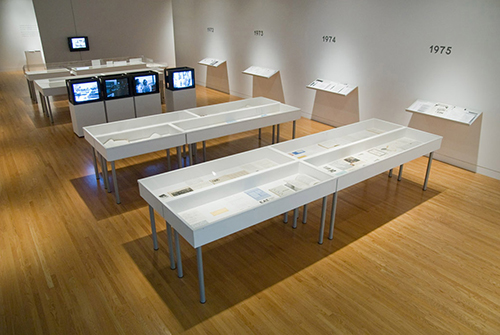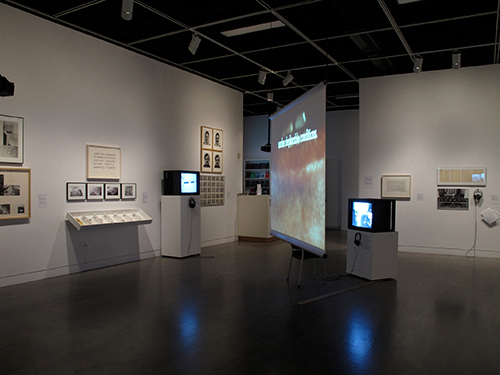Double milestone for Concordia gallery
It’s not unreasonable to think of Fermat’s Last Theorem, a mathematical equation that took 358 years to prove, as the sly title of a quirky work of contemporary art.
It isn’t, of course. Yet disparate as art and mathematics may be, they share fertile common ground in their propensity to puzzle and fascinate. Studies show that taking part in sustained art projects helps develop critical thinking. And for those interested in cultivating new ways of thinking, or questioning assumptions, there are arguably few better settings than Concordia’s Leonard and Bina Ellen Art Gallery.

While the gallery is home to works by such masters as Riopelle and Borduas, much has changed since acquisitions were its focus, beginning 50 years ago. My Treaty is With the Crown and This is Montreal!, recent out-of-the-ordinary exhibitions, are testament to the gallery’s current mandate.
Fifty years, as anniversaries go, resonate louder than 20-year milestones. Yet this year Concordia’s Ellen Art Gallery celebrates both. September marks two decades since the gallery opened in the then-newly built J.W. McConnell Library Building and a half century since artworks began to be collected at Sir George Williams University.
Its original collection of six works, acquired through a fund established in 1962 by Montreal entrepreneur Samuel Schecter, LLD 68, was first exhibited on campus in 1963. By the end of 1964, the holdings comprised 150 works and two years later the collection found a home in the new Henry F. Hall Building. In 1984, the space was rechristened the Concordia Art Gallery, a moniker that held until 1992 when it was renamed in honour of its eponymous benefactors, Leonard and Bina Ellen.
Over the years under the directorships of Concordia Professor Emeritus of art history Sandra Paikowsky, BA 67 (1981-1992), and Karen Antaki, BFA 82, MFA 92 (1992-2001), the gallery’s collection grew through various purchases but mostly through acquisitions by donations. The current collection, mainly Canadian works on paper and paintings from the 1960s to 1990s, comprises more than 1,700 objects.
In 1991, a generous contribution to Concordia’s capital fund by Leonard and Bina Ellen, along with other donations, enabled the gallery to expand, modernize and move into the new McConnell Building. On the gallery’s 10th anniversary, in 2002, President and Vice-Chancellor Frederick Lowy pledged the support of Concordia and the Concordia University Foundation.
With the contributions of donors and particularly the Ellen and Schecter families, as well as the Stern Estate, endowments of up to $2.5 million were established for the gallery.

At that moment, and for the first time in its history, Concordia launched a national competition for the position of director of the Ellen Art Gallery. As a result, Michèle Thériault was appointed in 2003. The positions of Max Stern Curator of the Collection and Coordinator of Education and Public Programs were created a year later.
Coherent thinking
Thériault’s appointment brought big changes. The gallery took on a stronger international outlook and its focus became strictly contemporary and curatorial. “Michèle has been able to really carve out a niche within the university,” says Graham Carr, Concordia’s vice-president, research and graduate studies, whose sector oversees the gallery. “This is a gallery that’s very much a public art gallery engaged in research in curatorial practice and which generates interesting, well-crafted and sophisticated publications.”
Historical projects would still take place but in relation to the recent past and from a contemporary perspective. The gallery initiated an ambitious publication program and, because of storage limitations, declared a moratorium on collecting. Thériault felt it important to “refocus” on programming and curating. “Collecting and the collection needed to emerge from and contribute to the overall programming,” she recalls.
In 2011, the gallery began acquiring again but within the framework of a new policy tied to programming. Six works, all of which had connections to the gallery’s exhibitions, were purchased. All have been shown more than once and borrowed by institutions such as the Musée d’art contemporain de Montréal for its Quebec Triennial.

Thériault’s strategy led to a tripling of its Canada Council for the Arts funding in the first six years of her directorship. In the context of university art galleries, she has helped consolidate the Ellen Art Gallery’s reputation in Canada as a major player in the presentation and dissemination of contemporary art worldwide. She has emphasized the critical dimension of curatorial practice and its relationship with artmaking, writing and dissemination. “The gallery is recognized as a place where the curatorial framing of exhibitions and events are publicly tested and discussed,” Thériault says.
In other words, there is deep thinking or “coherence” behind its programming. Coherence, Thériault conveys, lies in linking together exhibitions, works, publications, talks, lectures, film, so that each inflects the other to draw out the complexity of both artmaking and of curatorial experience. “In our programming, it is also about connecting the recent past with the present.”
For instance, Documentary Protocols had visitors peer through “vitrines” at mostly administrative documents (reports, seals, notary acts, grant applications) in an exhibition that examined the administrative ethos in artistic practices of the 1960s and '70s in Canada and the transformation of the artist into an administrator.
Documentary Protocols was austere — and not necessarily seductive to mainstream audiences. Yet crowd-pleasing or easy accessibility, says Thériault, is not foremost when mounting an exhibition. “My criteria and the criteria of the people who I work with is to ask: ‘Is this project contributing to knowledge on artistic issues?’ It’s just like the mission of the university: to foster critical thinking and develop knowledge.”
Thériault points out that the public can interpret things the way they want and in diverse ways. “As a gallery within a university we need to offer audiences pedagogical tools to encourage and develop understanding and various forms of interpretation; our tools are our public programs.”

She cites Ways of Thinking. Available in print and on the gallery’s website, it offers primary information about each curatorial project, the works that it addresses and the curator. Ways of Thinking raises questions, too. Its objective is not only to draw the public into the gallery and make them comfortable with their experience but also prepare teachers and students for their own visits.
“The Ellen Art Gallery makes unusually extensive use of guest curators,” says Patricia Grattan, BA 66, former director of Memorial University’s Art Gallery. “This seems to me not just a distinctive characteristic but a significant contribution to the development of curatorial practice in this country.”
If art today is, at times, mistakenly viewed as an extension of the entertainment industry, the Ellen Art Gallery is resolute in focusing on its complexity and how it is embedded within society. Yet the relationship of contemporary art to the public and media is often fraught. How contemporary art is received by audiences is the subject of Interactions, the gallery’s anniversary exhibition that runs until Saturday, October 27. Curated by Mélanie Rainville, the Max Stern Curator, Interactions features works from the collection and by artists from Quebec, France, Taiwan and the Palestinian territories and considers questions of reception and interpretation by “problematizing” those notions.
“Her exhibition will not only foster a discussion on the subject but will examine different approaches to how one receives contemporary art,” Thériault says. “Many find contemporary art difficult to access, don’t understand it or find it opaque. So we want to look into that gap that often exists between the general public and contemporary art.”
Whether Rainville’s Interactions pleases or perplexes its audience remains to be seen. Either way, there will be critical thought, which is always welcome at Concordia.
Leonard and Bina Ellen Art Gallery: 50th anniversary events
The Leonard and Bina Ellen Art Gallery has planned a series of events and projects to highlight its anniversaries. They include an online exhibition, exhibitions in a satellite “white cube” called Sightings, an ambitious autumn exhibition, Interactions, addressing the reception of contemporary art, a series of lectures on innovative projects developed by university art galleries across Canada, as well as a tour of Interactions during Homecoming 2012.
Sightings features works from the gallery’s collection and is curated by graduate students in Concordia’s art history and studio art programs. In all, five exhibitions take place in a large white cube located on the metro level in the Engineering, Computer Science and Visual Arts Integrated Complex. Sightings offers an opportunity for students and the public to become familiar with the gallery’s collection in a new setting, while allowing students to develop their curatorial skills.
This article initially appeared in the fall 2012 issue of the Concordia University Magazine.